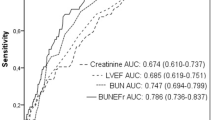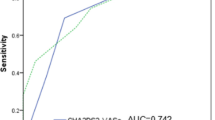Abstract
Background
There is a rising incidence of contrast-induced nephropathy (CIN), which is defined as either a 25% relative increase or an absolute increase of 0.5 mg/dL (44.2 µmol/L) in the serum creatinine (Scr) level at 48–72 h after administration of iodinated contrast media (CM). We investigated the relationship between left ventricular end-diastolic pressure (LVEDP) and CIN in patients undergoing percutaneous coronary intervention (PCI).
Methods
A total of 431 consecutive patients with coronary artery disease undergoing PCI were divided into four groups based on LVEDP quartile cut-off points. Enrolled patients were given continuous intravenous infusion of normal saline starting 4 h before PCI and lasting 24 h. At the end of hydration administration, 20 mg furosemide was slowly injected intravenously. Serum creatinine (Scr), creatinine clearance rate (Ccr), and glomerular filtration rate (GFR) were detected before and after PCI.
Results
There were significant differences in the incidences of CIN in the four groups: 10.25% in the Q1 group, 5.55% in the Q2 group, 5.31% in the Q3 group, and 1.06% in the Q4 group (P < 0.05). With increasing LVEDP, the incidence of CIN decreased significantly (OR 0.581, 95% CI 0.367–0.920). Received operating characteristic curve analysis of the predictive value of LVEDP for CIN produced area under the curve values was 0.641, with a sensitivity of 74.1% and specificity of 48%. The optimal LVEDP cut-off for the occurrence of CIN was 14.5 mmHg.
Conclusions
LVEDP correlated inversely with CIN in patients undergoing PCI.

Similar content being viewed by others
References
Morcos SK, Thomsen HS, Webb JA. Contrast-media-induced nephrotoxicity: a consensus report. Contrast Media Safety Committee, European Society of Urogenital Radiology (ESUR). Eur Radiol. 1999;9(8):1602–13.
Nash K, Hafeez A, Hou S. Hospital-acquired renal insufficiency. Am J Kidney Dis. 2002;39(5):930–6.
Jorgensen AL. Contrast-induced nephropathy: pathophysiology and preventive strategies. Crit Care Nurse. 2013;33(1):37–46.
Mehran R, Aymong ED, Nikolsky E, Lasic Z, Iakovou I, Fahy M, et al. A simple risk score for prediction of contrast-induced nephropathy after percutaneous coronary intervention: development and initial validation. J Am Coll Cardiol. 2004;44(7):1393–9.
Ohno I, Hayashi H, Aonuma K, Horio M, Kashihara N, Okada H, et al. Guidelines on the use of iodinated contrast media in patients with kidney disease 2012: digest version: JSN, JRS, and JCS Joint Working Group. Clin Exp Nephrol. 2013;17(4):441–79.
Weisbord SD, Palevsky PM. Prevention of contrast-induced nephropathy with volume expansion. Clin J Am Soc Nephrol. 2008;3(1):273–80.
Chen H, Lin G, Wang J. Practice of internal medicine, 14th ed. People’s Medical Publishing House; 2013;249:275.
Mao H, Cao L. Cardiology, 2nd edn. Shelton:People’s Medical Publishing House; 2001, pp 410–13
He YT, Tan N, Liu YH, Chen SQ, Liu Y, Huang SJ, et al. Association between high-sensitivity C-reactive protein and contrast-induced nephropathy after primary percutaneous coronary intervention. Zhonghua Xin Xue Guan Bing Za Zhi. 2013;41(5):394–8.
Brar SS, Shen AY, Jorgensen MB, Kotlewski A, Aharonian VJ, Desai N, et al. Sodium bicarbonate vs sodium chloride for the prevention of contrast medium-induced nephropathy in patients undergoing coronary angiography: a randomized trial. JAMA. 2008;300(9):1038–46.
Marenzi G, Ferrari C, Marana I, Assanelli E, De Metrio M, Teruzzi G, et al. Prevention of contrast nephropathy by furosemide with matched hydration: the MYTHOS (Induced Diuresis With Matched Hydration Compared to Standard Hydration for Contrast Induced Nephropathy Prevention) trial. JACC Cardiovasc Interv. 2012;5(1):90–7.
Gu GQ, Lu R, Cui W, Liu F, Zhang Y, Yang XH, et al. Low-dose furosemide administered with adequate hydration reduces contrast-induced nephropathy in patients undergoing coronary angiography. Cardiology. 2013;125(2):69–73.
Putzu A, Boscolo Berto M, Belletti A, Pasotti E, Cassina T, Moccetti T, et al. Prevention of contrast-induced acute kidney injury by furosemide with matched hydration in patients undergoing interventional procedures: a systematic review and meta-analysis of randomized trials. JACC Cardiovasc Interv. 2017;10(4):355–63.
Author information
Authors and Affiliations
Corresponding author
Ethics declarations
Conflict of interest
The authors have declared that no conflict of interest exists.
Human and animal rights
All procedures performed in studies involving human participants were in accordance with the ethical standards of the the Second Affiliated Hospital of Hebei Medical University, at which the studies were conducted (IRB Approval Number 2014031) and with the 1964 Helsinki declaration and its later amendments or comparable ethical standards, Ethics Committee approval has been obtained.
Informed consent
Informed consent was obtained from all individual participants included in the study.
About this article
Cite this article
Gu, G., Xing, H., Zhou, Y. et al. Inverse correlation between left ventricular end-diastolic pressure and contrast-induced nephropathy in patients undergoing percutaneous coronary intervention. Clin Exp Nephrol 22, 808–814 (2018). https://doi.org/10.1007/s10157-017-1514-6
Received:
Accepted:
Published:
Issue Date:
DOI: https://doi.org/10.1007/s10157-017-1514-6




